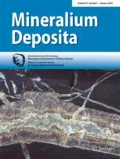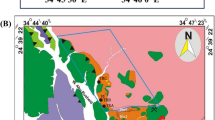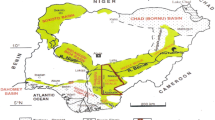Abstract
The Blockspruit fluorite prospect, located in North West State of the Republic of South Africa, occurs within an actinolite rock zone that was emplaced into the Kenkelbos-type granite of Proterozoic age. There are a large number of termite mounds in the prospect. For geochemical prospecting for rare earth elements (REEs), in total, 200 samples of termite mound material were collected from actinolite rock and granite zones in the prospect. Geochemical analyses of these termite mound materials were conducted by two methods: portable X-ray fluorescence (XRF) spectrometry and inductively coupled plasma-mass spectrometry (ICP-MS). Comparison of the two methods broadly indicates positive correlations of REEs (La, Ce, Pr, Nd, and Y), in particular Y and La having a strong correlation. As the result of modal abundance analyses, the actinolite rock at surface mainly consists of ferro-actinolite (89.89 wt%) and includes xenotime (0.26 wt%) and monazite (0.21 wt%) grains as REE minerals. Termite mound materials from actinolite rock also contain xenotime (0.27 wt%) and monazite (0.41 wt%) grains. In addition, termite mound materials from the actinolite rock zone have high hematite and Fe silicate contents compared to those from granite zone. These relationships suggest that REE minerals in termite mound materials originate form actinolite rock. Geochemical anomaly maps of Y, La, and Fe concentrations drawn based on the result of the portable XRF analyses show that high concentrations of these elements trend from SW to NE which broadly correspond to occurrences of actinolite body. These results indicate that termite mounds are an effective tool for REE geochemical prospection in the study area for both light REEs and Y, but a more detailed survey is required to establish the distribution of the actinolite rock body.











Similar content being viewed by others
References
Brooks RR (1982) Biological methods of prospecting for gold. J Geochem Explor 17:109–122
Crocker IT, Martini JEJ, Söhnge APG (1988) The fluorspar deposits of the Republics of South Africa and Bophuthatswana, Handbook 11. Geological Survey of South Africa
Crocker IT, Eales HV, Ehlers DL (2001) The fluorite, cassiterite and sulphide deposits associated with the acid rocks of the Bushveld Complex. Memoir 90, Council for Geoscience, Pretoria, South Africa, pp115
Ferrar P (1982) Termites of a South African savanna I.List of species and subhabitat preferences. Oecologia (Berl) 52:125–132
Gleeson CF, Poulin R (1989) Gold exploration in Niger using soils and termitaria. J Geochem Explor 31:253–283
Hoshino M, Watanabe Y, Tsunematsu M (2013) Rare earth minerals in amphibolites from Blockspruit fluorite deposit, the Republic of South Africa. Rare Earths 62, Rare Earth Society of Japan, 94-95. (in Japanese with English abstract)
Le Roux JP, Hambleton-Jones BB (1991) The analysis of termite hills to locate uranium mineralization in the Karoo Basin of South Africa. J Geochem Explor 41:341–347
Sarala P (2013) Portable XRF methods in till geochemical exploration- examples from Finland. Extended abstracts of SGA2013 Conference, Uppsala, Sweden, 437-439
Watson JP (1972) The distribution of gold in termite mounds and soils at a gold anomaly in Kalahari sand. Soil Sci 113:317–321
West WF (1970) The Bulawayo symposium papers: no. 2, termite prospecting. Chamb Mines J 12:32–35
Acknowledgements
We are grateful to Dr. Elisa Longa Tongu (Council for Geoscience, Republic of South Africa) for supporting our fieldwork in South Africa, to Dr. Akira Imai (Akita University, Japan) for revising a draft version of the manuscript, and to Dr. Masatsugu Ogasawara (Geological Survey of Japan) for suggesting technique of XRF analysis. This manuscript was significantly improved by the reviews of an anonymous reviewer and Editor-in-Chief Prof. B. Lehmann and Associate Editor Dr. D. Huston.
Author information
Authors and Affiliations
Corresponding author
Additional information
Editorial handling: D. Huston and B. Lehmann
Electronic supplementary material
Below is the link to the electronic supplementary material.
Table S2
(DOC 479 kb)
Rights and permissions
About this article
Cite this article
Horiuchi, Y., Ohno, T., Hoshino, M. et al. Geochemical prospecting for rare earth elements using termite mound materials. Miner Deposita 49, 1013–1023 (2014). https://doi.org/10.1007/s00126-014-0550-3
Received:
Accepted:
Published:
Issue Date:
DOI: https://doi.org/10.1007/s00126-014-0550-3




